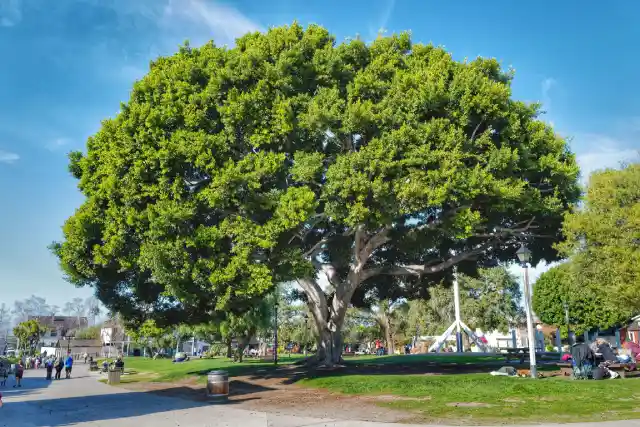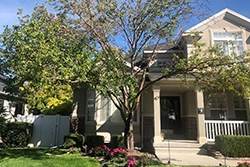Tree Health Care in Utah: Expert Guide from Diamond Tree Experts
Tree health care keeps trees alive through proper maintenance, early problem detection, and professional treatment when needed. In Utah’s climate, trees face alkaline soil, temperature swings, drought stress, and elevation changes that most tree care guides don’t address properly.
Diamond Tree Experts has diagnosed and treated tree health problems across Salt Lake County for 57+ years. We’ve seen every tree disease and pest issue that affects Utah trees. We know which treatments actually work in our alkaline soil and which ones waste your money. This guide shares specific insights from decades of hands-on experience treating Utah trees.
What We’ve Learned About Utah Tree Health Care
After 57 years of tree health care in Utah, we know the biggest mistake homeowners make. They follow generic tree care advice that doesn’t work in our unique environment. What works in Oregon or Colorado often fails in Utah’s alkaline soil and semi-arid climate.
Soil management comes first because everything else depends on it. Utah’s alkaline soil creates iron chlorosis in 60% of the trees we treat. Yellow leaves with green veins starting with newer growth. We’ve tested thousands of soil samples across Salt Lake County. pH levels typically run 7.5 to 8.5 when most trees need 6.0 to 7.0.
We’ve found that soil acidification works better than iron supplements for long-term iron chlorosis treatment. Most companies just inject iron because it’s easier. But we’ve tracked results over 10+ years. Acidifying soil produces healthier trees that need fewer treatments.
Water management in Utah requires understanding our clay soil layers. Most properties have clay at 18-24 inches deep. This creates a perched water table that drowns roots during heavy irrigation. We’ve dug thousands of root zones. Poor drainage kills more Utah trees than drought.
Deep, infrequent watering sounds simple but most homeowners do it wrong. We recommend 1-2 inches per week applied over 6-8 hours using drip irrigation or soaker hoses. Sprinkler irrigation creates surface roots that fail during drought stress.
Get your free ESTIMATE
Give Us a Call: (801) 262-1596
Early Problem Detection From Our Experience
We’ve identified specific warning signs that indicate tree health problems 1-2 years before most homeowners notice anything wrong.
Leaf size reduction happens before leaf color changes. When leaves are 20-30% smaller than previous years, the tree is already stressed. We measure leaves on mature trees during annual assessments. Smaller leaves indicate root problems or nutrient deficiencies.
Branch dieback patterns tell us what’s wrong. Random dead branches throughout the canopy usually indicate root problems. Dead branches starting from the top and working down suggest drought stress or vascular disease. Dead branches starting from the bottom indicate shading or poor air circulation.

Bark texture changes before bark color changes. Healthy bark should feel firm and uniform. Soft spots indicate internal decay. Raised areas often indicate pest activity beneath the bark. We check bark texture during every assessment.
Growth rate changes occur 2-3 years before visible decline. Trees should add 12-24 inches annually depending on species and age. When growth drops below 8 inches annually, we start investigating underlying causes.

Utah-Specific Diseases We Treat Regularly
Fire blight affects 40% of fruit trees and ornamental trees we treat in Utah. We see infection patterns that correlate with spring weather. Warm days above 65°F followed by rain or hail creates ideal infection conditions.
The bacteria spreads through flowers, wounds, and natural openings. We’ve tracked infection timing across Salt Lake County for 20+ years. Peak infection occurs during apple and pear bloom, typically mid-April to early May depending on elevation.
Treatment requires removing infected branches 12 inches below visible damage.
We sterilize tools between cuts using 70% alcohol solution. Skip this step and you’ll spread the bacteria to healthy branches. We’ve seen entire orchards infected by contractors who didn’t sterilize tools.
Cytospora canker affects 80% of blue spruce trees over 15 years old in our service area. This fungal disease thrives in Utah’s variable moisture conditions. Drought stress followed by wet periods creates perfect conditions for infection.
Lower branches die first because the fungus blocks water transport. We’ve removed thousands of infected spruce trees. Once infection reaches the main trunk, tree removal becomes necessary. Early intervention saves trees and money.
Treatment involves removing infected branches during dry weather. Fall and winter treatments work better than spring treatments. Wet spring weather spreads fungal spores to healthy tissue.
Soil Chemistry Problems We Solve Daily
Utah’s caliche layer creates drainage problems that kill trees slowly. This calcium carbonate layer forms 2-4 feet below surface in many areas. We’ve encountered caliche on 70% of properties we assess.
Breaking through caliche during planting prevents future drainage problems. Most landscapers don’t dig deep enough to identify caliche. Trees planted above caliche develop shallow root systems that fail during drought or wind storms.
We use soil augers to identify caliche depth before recommending tree locations. Planting locations with caliche within 3 feet of surface require drainage improvements or different tree species selection.
Salt accumulation from road treatments affects trees within 50 feet of roads. We measure soil conductivity on properties near busy streets. Salt levels above 2.0 dS/m damage sensitive trees like maples and birch.
Gypsum applications help leach salt from root zones. We apply 40-60 pounds per 1000 square feet depending on salt levels. Results take 2-3 years but we’ve saved hundreds of salt-damaged trees using this method.

We sterilize tools between cuts using 70% alcohol solution. Skip this step and you’ll spread the bacteria to healthy branches. We’ve seen entire orchards infected by contractors who didn’t sterilize tools.
Cytospora canker affects 80% of blue spruce trees over 15 years old in our service area. This fungal disease thrives in Utah’s variable moisture conditions. Drought stress followed by wet periods creates perfect conditions for infection.
Lower branches die first because the fungus blocks water transport. We’ve removed thousands of infected spruce trees. Once infection reaches the main trunk, tree removal becomes necessary. Early intervention saves trees and money.
Treatment involves removing infected branches during dry weather. Fall and winter treatments work better than spring treatments. Wet spring weather spreads fungal spores to healthy tissue.
Utah’s Elevation Has Big Impact on Tree Health Care
Trees at different elevations across our service area face different challenges. Valley floor trees deal with temperature inversions, poor air quality, and higher salt concentrations. Foothill trees face wind exposure, temperature extremes, and better drainage.
We maintain trees from 4,200 feet elevation near the Great Salt Lake to 6,500 feet in the foothills. Pest timing changes by 2-3 weeks per 1000 feet of elevation. Treatment timing must account for elevation differences.
Mountain pine beetles active above 5,500 feet elevation don’t affect valley floor trees. But emerald ash borer problems concentrate in valley areas with warmer winter temperatures.
Species selection depends heavily on elevation. What thrives at 4,500 feet often struggles at 6,000 feet. We’ve tracked tree performance across elevation zones for 30+ years.
Professional Tree Health Care Treatment Methods That Work
Soil injection treatments work better than surface applications for most tree health problems. We inject fertilizers, fungicides, and soil amendments directly into root zones using high-pressure equipment.
Trunk injection delivers systemic treatments more effectively than soil applications. We use this method for emerald ash borer prevention, Dutch elm disease prevention, and severe iron chlorosis treatment.
Treatment timing affects success rates dramatically. Soil treatments work best during active root growth periods – late spring and early fall in Utah. Trunk injections work best during active water transport periods – late spring through mid-summer.
We track treatment success rates for every method we use. Some treatments that work well in other climates fail consistently in Utah. Our treatment protocols reflect 57 years of documented results, not generic recommendations.
When Professional Help Prevents Tree Loss
Tree health problems that affect tree survival need professional diagnosis within 30 days. We’ve documented rapid tree decline cases where healthy-looking trees died within 6 months of first symptoms.
Sudden branch dropping indicates internal decay or pest damage. Don’t wait to see what happens. We’ve seen trees drop large branches without warning, causing property damage and injury.
Multiple trees showing similar symptoms indicates environmental problems that affect entire landscapes. We’ve treated neighborhood-wide problems caused by contaminated irrigation water, soil-borne diseases, and pest outbreaks.
Insurance claims for tree-related property damage require professional documentation. We provide detailed assessments and treatment records for insurance purposes. Poor documentation often results in denied claims.
Preventive Programs That Save Money
Our preventive tree health programs cost 60-70% less than reactive treatment after problems develop. We’ve tracked maintenance costs for clients over 20+ years. Properties with regular preventive care spend less money on tree care long-term.
Annual assessments identify problems during early stages when treatment options exist. Once trees decline beyond 50% canopy loss, removal often becomes the only option. Early intervention saves trees and money.
Soil improvement programs prevent nutrient deficiency problems before they affect tree health. We amend soil pH, improve drainage, and add organic matter during tree establishment. Trees with proper soil management need fewer treatments throughout their lifetime.
Pest monitoring programs identify infestations before visible damage occurs. We monitor for emerald ash borer, mountain pine beetle, and other destructive pests using pheromone traps and visual inspections.
Working With Utah Tree Health Experts
Choose tree health professionals with documented Utah experience and ISA certification. Local knowledge matters more than general certification. Ask for references from similar projects in your area and soil conditions.
Request written treatment plans that explain diagnosis, treatment options, expected outcomes, and success rates. Avoid companies that provide verbal estimates without written documentation.
Diamond Tree Experts combines 57 years of documented Utah tree care experience with modern diagnostic equipment and treatment methods. Our treatment protocols reflect decades of tracked results in Utah’s unique growing conditions.
We understand soil chemistry variations across Salt Lake County, pest cycles at different elevations, and disease pressure patterns that vary by microclimate. This local expertise produces better treatment outcomes than generic approaches.
Contact Diamond Tree Experts for professional tree health assessment based on 57+ years of Utah experience. Our assessments include soil testing, pest monitoring, and treatment recommendations specific to your trees and growing conditions.













